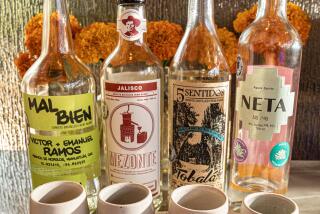Tequila: The Fusion Hootch
- Share via
As we all know, tequila is a variety of mezcal, the rustic Mexican brandy made from the heart of the agave plant. The heart first has to be baked to convert its starches to sugars. The resulting sweet juice (aguamiel) can be fermented and distilled.
The practice of baking agave hearts is ancient in Mexico. Originally they were baked in stone-lined underground pits heated by keeping a fire going in them for couple of hours, much as for a New England clambake or a Hawaiian imu pit barbecue. But in pre-Columbian times, agave was mostly baked for food. Nobody was making tequila from the aguamiel because the Aztecs were ignorant of distillation, though they did know about fermentation and sometimes fermented aguamiel.
So did some Spanish colonist just take a look at aguamiel wine one day and say, “Aha--let’s distill it”?
Apparently not. Village people in the tequila country use peculiar stills, quite unlike the European type in which the alcohol vapor condenses in a water-cooled copper tube. In these village stills, it condenses on the underside of the lid of the vaporization chamber itself. The lid is concave; the vapor condenses on it because the top of the lid holds some cold water.
The alcohol drips from the lid into a little cup hanging inside the chamber, and from time to time you remove the lid and harvest your mezcal. Sure, it’s nowhere near as efficient as a European copper still, but you don’t need any metal to make one; you can use pottery.
This is a Southeast Asian design that seems to have come from the Philippines as an unplanned consequence of Spain’s 17th and 18th century trade with its Philippine and American colonies. An unknown Filipino immigrant evidently tasted aguamiel, thought of sugar cane juice and the native rums of his homeland, and bingo: Tequila, or at least its remote ancestor, was born.
More to Read
Eat your way across L.A.
Get our weekly Tasting Notes newsletter for reviews, news and more.
You may occasionally receive promotional content from the Los Angeles Times.










